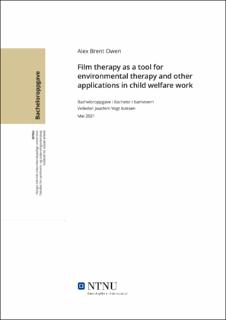| dc.contributor.advisor | Isaksen, Joachim Vogt | |
| dc.contributor.author | Owen, Alex Brent | |
| dc.date.accessioned | 2021-09-28T18:48:58Z | |
| dc.date.available | 2021-09-28T18:48:58Z | |
| dc.date.issued | 2021 | |
| dc.identifier | no.ntnu:inspera:79529906:34915003 | |
| dc.identifier.uri | https://hdl.handle.net/11250/2785811 | |
| dc.description.abstract | SAMMENDRAG
Filmterapi er en form for intervensjon som har vist lovende resultater i sin anvendelse hos barn med forskjellige utfordringer. Til tross for disse lovende resultatene fra tidligere studier, finnes det begrenset forskning på temaet. Denne oppgaven utforsker noen av de mest fremtredende studiene som hittil er gjort på bruk av filmterapi med barn. Formålet med denne oppgaven er å argumentere for at filmterapi kan være et effektivt verktøy for miljøterapeuter som jobber i barneverns- og familie sentre og institusjoner.
Denne oppgaven undersøker studier utført i USA, Iran og Italia om bruk av filmterapi eller kinoterapi på barn som sliter med forskjellige vansker og har forskjellige funksjonsnivåer. Etter å ha evaluert resultatene av disse studiene ble flere felles trekk tydelige. Trekk som en kan ta ut, sammenligne og applisere på barnevernsarbeid, spesielt miljøterapi. Disse studiene viste at filmterapi kan være en svært effektiv behandlingsform for barn som er beboere i en barneverns- og familie senter eller institusjon. F.eks. barn som sliter med rusmisbruk, opplever sosial dysfunksjon på grunn av dårlig psykisk helse, eller diagnostiseres med autistisk spektrumforstyrrelse.
Denne oppgaven utforsker også en studie utført i Norge som intervjuet miljøterapeuter som jobber med barn for å finne ut hvordan de bruker systemisk teori i hverdagspraksisen. Denne studien viste betydningsfulle sammenhenger mellom filmterapi og miljøterapi, og hvordan de relaterer til hverandre gjennom narrativ terapi og bruk av metafor. Konklusjonen i denne oppgaven hevder at filmterapi og miljøterapi er kompatible behandlingsformer som kan brukes sammen: filmterapi kan være et viktig verktøy for å oppnå målene satt i miljøterapien. | |
| dc.description.abstract | ABSTRACT
Film therapy as a form of intervention has shown promise in its application toward children dealing with different issues. Despite the promising results of previous studies, limited research exists on the subject. This thesis paper explores some of the most prominent studies done to date on the use of film therapy with children. The purpose of this paper is then to argue that film therapy can be an effective tool for environmental therapists working in child welfare and family centers.
This paper examines studies performed in the US, Iran, and Italy regarding the use of film therapy or cinematherapy on children dealing with different issues and who have different levels of functioning. After evaluating the results of these studies, common traits were made apparent that could be extrapolated and compared to child welfare work, specifically environmental therapy. These studies showed that film therapy can be a highly effective treatment form for children who could potentially find themselves as residents of a child welfare or family center, such as children struggling with drug use, experiencing social dysfunction due to poor mental health, or diagnosed with autistic spectrum disorder.
This paper also explores a study conducted in Norway which interviewed environmental therapists working with children to find out how they use systemic theory in their everyday practice. This study was instrumental in connecting certain dots between the origins of film therapy and environmental therapy and how they are in many ways related through narrative therapy and the use of metaphor. The conclusion of this paper asserts that film therapy and environmental therapy are compatible treatment forms that can be used in tandem: film therapy as a tool to achieve the goals set out by environmental therapy. | |
| dc.language | eng | |
| dc.publisher | NTNU | |
| dc.title | Film therapy as a tool for environmental therapy and other applications in child welfare work | |
| dc.type | Bachelor thesis | |
